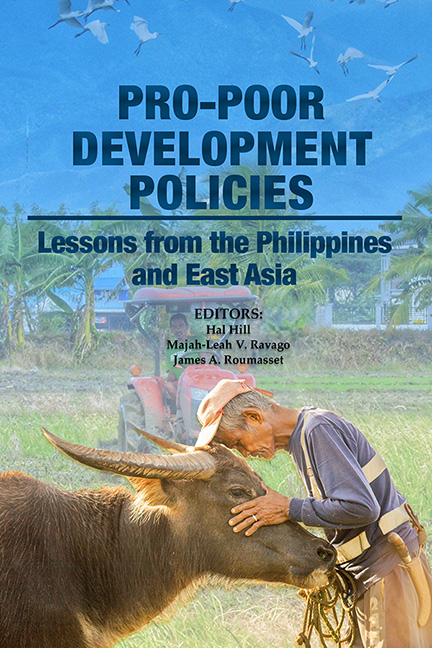Book contents
- Frontmatter
- Dedication
- Contents
- Figures, Tables and Boxes
- Foreword
- Foreword
- Message
- Preface and Acknowledgements
- About the Editors
- About the Contributors
- Acronyms
- Part 1 Introduction and Synthesis
- Part 2 Agricultural and Economic Development
- Part 3 Economic Policies for Achieving Targeted Levels of Living in the Philippines
- Part 4 Inequality and Economic Development
- Part 5 Competition Law and Policy
- Part 6 International Dimensions
- Index
24 - Modernization of the Global Rice Market
Published online by Cambridge University Press: 09 January 2024
- Frontmatter
- Dedication
- Contents
- Figures, Tables and Boxes
- Foreword
- Foreword
- Message
- Preface and Acknowledgements
- About the Editors
- About the Contributors
- Acronyms
- Part 1 Introduction and Synthesis
- Part 2 Agricultural and Economic Development
- Part 3 Economic Policies for Achieving Targeted Levels of Living in the Philippines
- Part 4 Inequality and Economic Development
- Part 5 Competition Law and Policy
- Part 6 International Dimensions
- Index
Summary
INTRODUCTION
Since 2012, India has been the top exporter of rice in the world market, taking over from Thailand and Vietnam. At the same time, China has become the number one importer of rice, overtaking the Philippines and Indonesia. Factors that have caused these changes will define the future environment for the rice market in the twenty-first century.
Rice and its products will continue to contribute significantly to the nutritional needs of a large proportion of the world population for decades to come. Rice will continue to generate employment for a significant number of workers around the world throughout its production, processing and marketing value chain. It will remain one of the most politically sensitive products for most governments.
The rice value chain has undergone a major transformation in the past decade, embracing automation and digital technology. New business models have emerged, reorganizing the industry in both domestic and international markets. The existing system and policy environment of the twentieth century may need to be adjusted to the requirements of the future. A market-based cooperative solution may be more effective and efficient in achieving rice security and environmental sustainability for each country and the global market.
The availability of staple foods such as rice is a global issue that needs a global solution. This modernized market is an opportunity to reduce the sensitivity of rice supply by strengthening the production and delivery system and by making separate arrangements for emergency situations.
The next section highlights some key changes in the rice market. Section 3 tackles the main drivers of these changes that will continue to shape the future of the rice market. Section 4 discusses possible reforms for the rice market in the twenty-first century. It attempts to broadly follow the nature-cause-and-consequence paradigm for policy analysis suggested by Roumasset (2015).
CHANGES IN THE GLOBAL RICE MARKET
Some changes in the structure of the global rice market have become more evident since the turn of the millennium. These changes may continue into the future and redefine the landscape of the global rice market.
- Type
- Chapter
- Information
- Pro-poor Development PoliciesLessons from the Philippines and East Asia, pp. 697 - 726Publisher: ISEAS–Yusof Ishak InstitutePrint publication year: 2022



